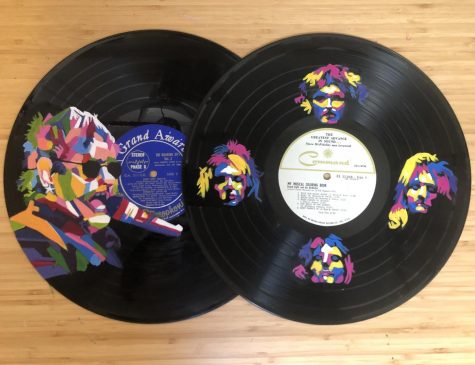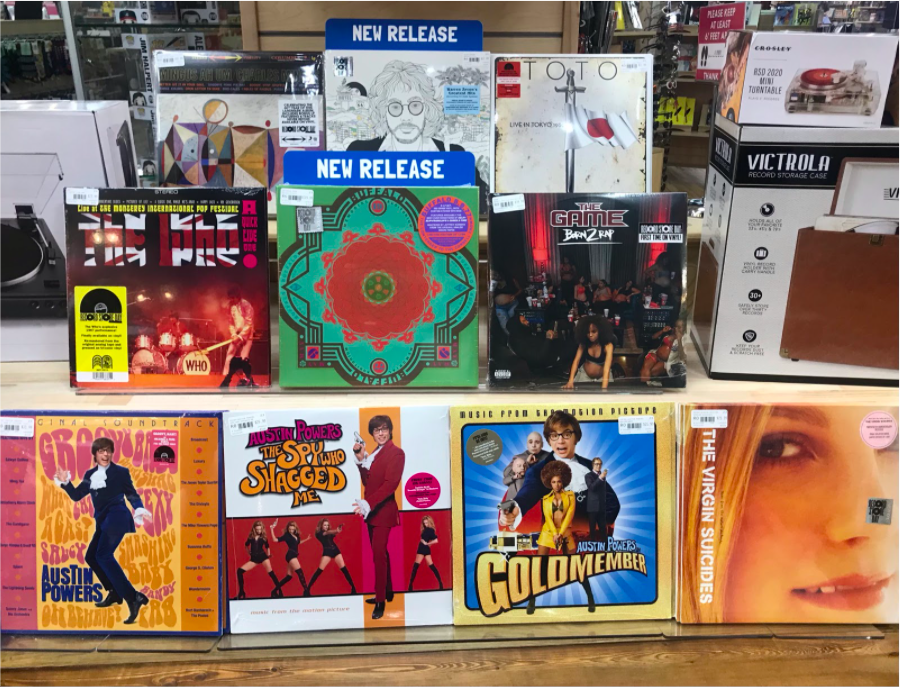Record Store Day 2020: Supporting Musicians or Supporting the Earth?
Vinyl records are not just trendy and nostalgic – they’re toxic.
The October 24th, 2020 Record Store Day releases are displayed at the front of Newbury Comics, ranging from special pressings of classic bands like ‘TOTO,’ ‘The Who,’ and ‘Boston,’ to the more off-beat ‘Austin Powers’ movie soundtracks.
Four days a year for the last thirteen years, music lovers have been able to show their appreciation for their favorite artists through ‘Record Store Days’ — a day that celebrates the unique culture of physical albums. The most recent one was this past October 24th, 2020, when record stores stocked their shelves with limited edition vinyl records from a wide variety of artists. This year’s line-up included the likes of modern-day pop pioneer, ‘The Weeknd,’ legendary 60’s rock group, ‘The Who,’ and more unusual titles from artists like ‘The Pineapple Thief.’ These rare albums, printed in quantities ranging from 500 to 10,000 units, give listeners a special chance to feel more connected with their favorite songs and artists and to indulge in a rich soundscape at the same time.
The power of vinyl records is undeniable. With their unmatched sound quality, vinyl records provide an intimate and immersive musical experience that can be enjoyed from the comforts of one’s home. After a lull in sales in the 1990s, the recent rise of vinyl record sales exemplifies the appreciation that younger generations have for this auditory art form. But with great power comes great responsibility, and behind the vibrant and sleek record sleeves lies a concoction of toxic chemicals, a recipe for the destruction of our planet.
The manufacturing process needed to make vinyl records produces tons of water waste, the plastic packaging encasing the records is non-recyclable, and the cover art on many record sleeves is made with ozone-producing ink. Yet this is not nearly the pinnacle of the environmental issues with vinyl records. The vinyl record itself, made of PVC (polyvinyl chloride), takes up to 1,000 years to degrade in a landfill, giving new meaning to the phrase, ‘the timelessness of music.’
These unsustainable practices produce a tug-of-war between supporting the arts versus supporting our planet. Sara Poon ’21, Manager of the Bronx Science Animal Squad and a senior member of the Green Team, noted that “artists, like small business owners or even mainstream creators, make a portion of their living through merchandise sales or commissions, some of which contribute to a lot of waste when it comes to packaging and production.” There is a silver lining for patrons of the arts who are torn, however. With hundreds of alternatives available to buying ‘hot off the press’ vinyl records, there is a green option out there for anyone on the spectrum of music lovers, from die-hard audiophiles to casual listeners willing to kick their vinyl habit.
Eliminating PVC From Music
When records were first created in the late nineteenth century, they were made of glass and zinc, which was both highly fragile and had poor sound quality. It was at the turn of the twentieth century, following an industrial age, that PVC became the choice material for both consumers and producers. In our more eco-conscious times, however, some record manufacturers are beginning to acknowledge the damage that they are doing by continuing to use PVC records.
While the technology is still in its infancy, 3-D printed records are the strongest contender for the future of physical music. Although 3-D printing is not net zero-waste, it does offer an overall green solution to record pressing, using recyclable and biodegradable materials in order to make the records and eliminating the need for water in record-pressing. In an article from Bogar Alonso for Vice News, Alonso highlights artist Amanda Ghassaei’s work in making 3-D printed records on a variety of mediums, including compostable alternatives such as wood and paper. Although the sound quality is still very poor and full of surface noise, there is a strong hope that Ghassaei’s work will catapult us into a new age of physical music.
Green Alternatives at the Moment
For those who are unwilling to wait indefinitely for whenever new vinyl technology will be ready for consumption, there are still ways to be a more eco-conscious consumer.
Thrift stores and mom-and-pop record stores are a great way to find old records (and put money into small businesses). I have had personal luck in finding many old records in perfect condition — albeit after much sifting through cracked and scratched records, all at the fraction of the cost of new records (prices typically range from $2.00 to $10.00.)
A few record labels are working to bring environmental ethical standards into their manufacturing processes, including the Canadian company Viryl Technologies and the Dutch company Green Vinyl records, who are spearheading the elimination of water waste with their steamless pressing technology. Ninja Tune is yet another underground label that is trying to reframe its philosophy to be more eco-conscious. While currently working on offering more sustainable packaging, the company also hopes their records will go to good use, envisioning “easier recycling of vinyl overstocks into umbrellas or the like,” said Co-CEO of Ninja Tune, Peter Quicke, in an interview with The Vinyl Factory.
Repurposing Old Records
When records cannot be played anymore, after hundreds of trips around the turntable and scratches to show for this, what happens to them? While recycling vinyl records is a great option, vinyl recycling facilities are few and far between in many parts of the United States. To see if a vinyl-recycling facility is near you, you can check out this map.
If you do not have access to vinyl recycling or if you still want to continue to enjoy your favorite records, try turning your records into a new form of art. Many record sleeves can easily be used as wall decor, as can the vinyl records themselves. If you are feeling particularly creative and do not mind being blasphemous to audiophiles, you can also opt to paint your vinyl records, allowing you to infuse your own style with the work of artists you admire.

Supporting Artists in a Digital World
In our digital age, it has never been easier to support your favorite artists. “You can always just choose to make electronic purchases, like e-books and music albums, or buy tickets to an experience, like concerts or meet and greets, in order to be a supporting fan,” said Poon. To adapt to the changing world in which we live, many artists have now also launched livestream concerts, with tickets ranging from $0 – $50 (every week, Anna Chan for Billboard creates a new list of upcoming live streams. See her articles here).
Spotify pays artists for every stream that they get, meaning that you can put money into the pockets of your favorite artists without spending anything. With the massive community of music lovers on these apps, musicians end up seeing more profits from digital music than they do from physical music, making it no wonder that streaming is now responsible for 75% of revenue in the music industry.
When you are a true fan of music, you do not need a special day of the year to show up for your favorite artists. There is no such thing as a choice between art and the environment — when you’re being a conscious consumer, you can continue to press play with a green thumb.
With hundreds of alternatives available to buying ‘hot off the press’ vinyl records, there is a green option out there for anyone on the spectrum of music lovers, from die-hard audiophiles to casual listeners willing to kick their vinyl habit.
Jiada Valenza is Senior Facebook Editor and an Arts and Entertainment Editor for ‘The Science Survey,' helping to manage the newspaper's social media...











